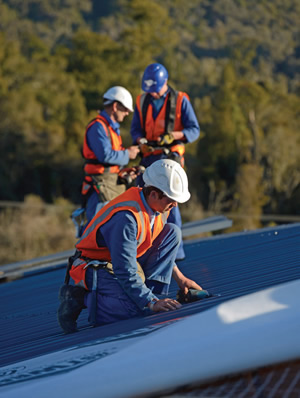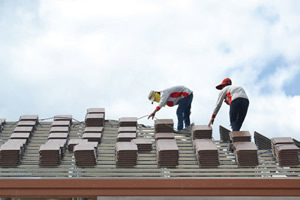Facilities (Learning Spaces)
Choosing the Right Roof
- By Ellen Kollie
- March 1st, 2015

PHOTO © LAKEVIEW IMAGES / SHUTTERSTOCK.COM
The roof is a complex, challenging and important component of a well-built school, so it’s important to get it right. School Planning & Management asks Bill Good, executive vice president of Rosemont, Ill.-based National Roofing Contractors Association (NRCA) about the factors that go into the decision-making process. Established in 1886, NRCA is the leading authority in the roofing industry for information, education, technical assistance, advocacy, publications, programs and support. Here’s what he has to say.
SPM: Are building owners looking for the “best” roof or the “right” roof?
GOOD: They’re looking for the “right” roof. There are core materials we use, such as asphalt-based products, metal, thermoplastics and others. And they all work well together if the building is suitable, the roof is well designed and the material installed correctly. So it’s really about making the right choice rather than the best choice.
SPM: Why is choosing the right roof for a school important?
GOOD: First of all, we always want the roof to do its main job, which is to keep out the elements; keep the building dry, warm and safe; last for a long period of time, and perform in such a way that it doesn’t require a lot of constant attention.
Recently, we’re paying more attention to roofs because we’re learning they can play an important part in energy conservation. In buildings with a lot of roof area, such as schools, most of the heat and cooling loss is through the roof. If we can determine how to prevent that from happening, we can save a lot of energy through a long period of time.
Finally, through the roof, we can help preserve and protect the environment. We’re learning more about this all the time. For instance, in some climates, such as large urban areas, having a reflective roof surface can help with energy conservation, but it can also reduce the ambient temperature. We’re asking such questions as: Where do reflective roof surfaces make sense? We’re also looking at putting vegetation on roofs, partly because it looks good and partly to control storm water runoff. And, in a lot of instances, we’re putting solar panels on roofs to produce energy. All of these factors should be considered when making a roofing decision. Some of those alternatives can begin to make sense depending on where the roof is located.
SPM: Is there a standardized guideline for determining the right roof, such as a Venn diagram?
GOOD: No, there isn’t. The reason there isn’t is because there are so many variables. One, for instance, is the facility’s geographic location. Maine’s environment is different from Florida’s so that roofs in Maine require more insulation and roofs in Florida require more reflectivity. Another variable is the facility’s structural capabilities and components. For example, some roofs can support the weight of vegetation, while others can’t.
There are some models that can be helpful tools in the decision-making process. For example, the Center for Environmental Innovation in Roofing (Center) (www.roofingcenter.org) has RoofPoint, a green rating system for building owners to use to determine what roof makes sense based on long-term energy and environmental benefits in five strategic categories of sustainable roofing.
SPM: What cost factors must be considered in determining what roof goes on a school?
GOOD: We distinguish between low slope and steep slopes. Most schools have low slope roofs, and those usually have long-term guarantees and, sometimes, workmanship guarantees. Warrantees can be up to 20 to 30 years. It’s important to have an understanding of a roof’s life expectancy. Warranties are not a be-all, end-all, but they are a good starting point for knowing a roof’s reasonable life expectancy. When school administrators are budgeting for roofs, life expectancy becomes an important factor. Another important factor is long-term energy payback, and there are ways to measure that. For example, if I add two inches of insulation, I can determine the energy savings and from that, I can determine the payback for the initial investment.
SPM: What sustainability factors must be considered in determining what roof goes on a school?
GOOD: Fundamentally, you want a roof that lasts a long period of time. For us, sustainability includes a number of factors. One is the recyclability of the materials and, today, most roof materials are recyclable. Facility managers should be asking if this is important to the organization. Another is disposability: What happens to the existing roof that is torn off? Can it be recycled? What portion of it will go to the landfill? A third factor is, as already discussed, the roof’s effect on the building’s energy consumption.
SPM: What performance factors must be considered in determining what roof goes on a school?
GOOD: First, last and always, the question is: How long is the roof going to last? We want to make sure it’s going to be there for the long term. A second question is: What are the energy components? Are there compatibility issues with other building materials that negatively affect energy performance? To sum, performance is centered around longevity first and energy performance second.

PHOTO © KHURUZERO / SHUTTERSTOCK.COM
Top Priority. The main purposes of a roof is to keep out the elements; keep the building dry, warm and safe; last for a long period of time, and perform in a way that it doesn’t require a lot of constant attention. They can also play an important part in energy conservation and, if designed properly, help preserve and protect the environment. So, it is important to choose the correct type for your needs, install it properly and then perform routine inspections and maintenance to ensure it is doing its job and extent its life.
SPM: What maintenance factors must be considered in determining what roof goes on a K-12 school?
GOOD: Administrators want to know what maintenance is required after the roof is installed. We recommend ongoing maintenance: having the installing contractor or another roof expert take a look to make sure that drains aren’t clogged, flashings are secure and attached correctly, and lap seams of applied membranes (sheets of TPO, PVC or EDPM) are intact, as well as look for other signs of trouble. Generally this routine is easy and inexpensive. If you can avoid a leak before it occurs, your maintenance cost is a good investment.
Another issue with installed roofs is managing other trades who get on the roof. A lot of schools have mechanical equipment, television antennas or cell phone towers on the roofs. This occurs because it’s out-of-sight real estate. If an HVAC mechanic works on the roof-installed equipment, facility managers want to make sure no damage occurred to the roof as a result. It’s always worthwhile to have someone experienced with the roof take a look around once other work is done. This is especially true if the roof has a manufacturer’s warranty, because it can be voided if somebody else damages the roof, such as installing something that calls for a screw to be driven through the roof.
SPM: How can administrators be sure they’re making the right choice?
GOOD: The roof is a team effort. The best strategy is for the team to work together. This includes the person responsible for the roof decision, and the designer, contractor and manufacturer. Having them all in communication is crucial to handling such issues as scheduling, material compatibility and warranty (in most cases, for the warranty to be valid, the installation must be done by an approved contractor).
SPM: Where can administrators turn for assistance to ease their decision-making angst?
GOOD: The NRCA website has free information; we encourage and welcome people to use it. RCI, Inc. (formerly the Roof Consultants Institute) (www.rci-online.org), has members who do consulting. Plus, virtually every roof materials manufacturer has technical representatives.
SPM: Once the right roof is installed, how can administrators be sure it performs effectively?
GOOD: We always recommend an inspection and/or maintenance program. If the roof is warranted, a lot of manufacturers require ongoing inspections and/or maintenance. With or without that, it makes sense to visit the roof a couple times a year to do a simple, one-hour walk-around that includes taking pictures. This is followed by repairing small issues before they become big issues. A walk-around is a good idea after winter — especially a hard winter like the winter of 2014 — as there have probably been some things going on up there. It’s also a good idea before winter to ensure the roof is tight and sound before bad weather.
Another idea is to extend the life of the roof by having it coated. A coating is typically applied once the roof has been in service for five to 10 years. A roof coating solution extends a roof’s life expectancy and also helps with energy conservation on reflective roof surfaces, which degrade through time.
SPM: What advice do you have to help administrators decide upon the best roof for their school?
GOOD: This comes as no surprise after what I’ve already said: Work with people with whom you’re comfortable. There are a lot of options and a lot of contractors, so choose people who are experienced and knowledgeable. Research the firm before making a commitment. And make sure the roofing contractor is licensed, bonded and insured, and has references and experience.
Make sure the contractor is approved by the manufacturer of the system that’s being installed. Not only is it an important piece of the warranty, but you don’t want installers working with products with which they have no experience. The installer must have a permanent place of business in order to repair future problems or perform regular maintenance. These are common sense, due diligence pieces of advice, but we know the day-to-day pressure of getting things done means these things are easy to overlook.
This article originally appeared in the March 2015 issue of School Planning & Management.